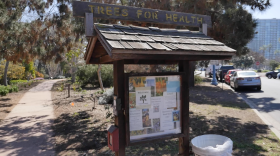The chairman of the Nuclear Regulatory Commission today visited the troubled San Onofre Nuclear Generating Station, but sidestepped questions about how long the plant's Units 2 and 3 would remain offline.
Gregory Jaczko came for a first-hand look at the problems that have been keeping the plant offline since the end of January, raising fears of power shortages this summer.
He was accompanied by Democratic Sen. Dianne Feinstein and Republican Rep. Darrell Issa when he visited the facility in northern San Diego County. He also discussed various issues with plant managers and NRC inspectors who have been investigating a small leak for the past two months.
Jaczko held a news conference following the tour, where he said until the root cause of the problems in the steam generators is discovered, the plant cannot be put back on line.
“The issue of the steam generators is a very serious issue,” he said. “We take it seriously and after some very frank discussions today, I can say that I believe Southern California Edison takes it seriously too. The bottom line is, we have to have assurances of safety before we can allow the plant to restart.“
"I don't want to speculate on a timeline,'' he added, referring to when the plant would be back online. "Certainly (the plant's workers) appreciate the importance of having the units operating and we're prepared to respond to do the reviews.''
Jaczko said it was a "very good tour,'' and added, "I got the strong impression the plant is taking it very seriously. They understand they need to get to the bottom of the issue.''
Inspectors are focusing on tubes in the steam generators that have shown "unexpected wear,'' agency spokesman Victor Dricks said.
Jaczko also inspected San Onofre's sea wall and safety improvements made since an earthquake and tsunami damaged the nuclear plant at Fukushima, Japan.
"They have a very robust program to address earthquakes and tsunamis,'' Jaczko said.
The environmental group “Friends of the Earth” released a statement following Jaczko’s visit, questioning the NRC’s acceptance of Edison’s claim that the new design was equivalent to the old one:
“The NRC will apparently investigate if and how Edison avoided oversight by claiming that replacement reactor equipment - costing hundreds of millions in ratepayer dollars - was an identical swap. Clearly that wasn't the case – the NRC has not only to hold Edison accountable but the Chairman needs to assure that the NRC’s own house is in order.”
Edison’s web site calls San Onofre "Southern California’s largest and most reliable source of electricity."
But tubes in the new system installed in the steam generators in the last two years leaked - leading to serious questions about the plant’s safety. In January it was shut down.
Nuclear Regulatory Commission spokesman Victor Dricks said there have been problems with similar tubes at other plants around the country, but no other plant has been shut down - and this problem is specific to the steam generators at San Onofre.
“They are virtually a unique design and no other plant in the United States has them,” Dricks said.
The Nuclear Regulatory Commission has already issued a letter with conditions Southern California Edison must meet before it can resume operations.
California’s Independent Systems Operator has recommended bringing a decommissioned power plant in Huntingdon Beach back on line to help meet demand in San Diego, if San Onofre is not back in operation for the summer months.







